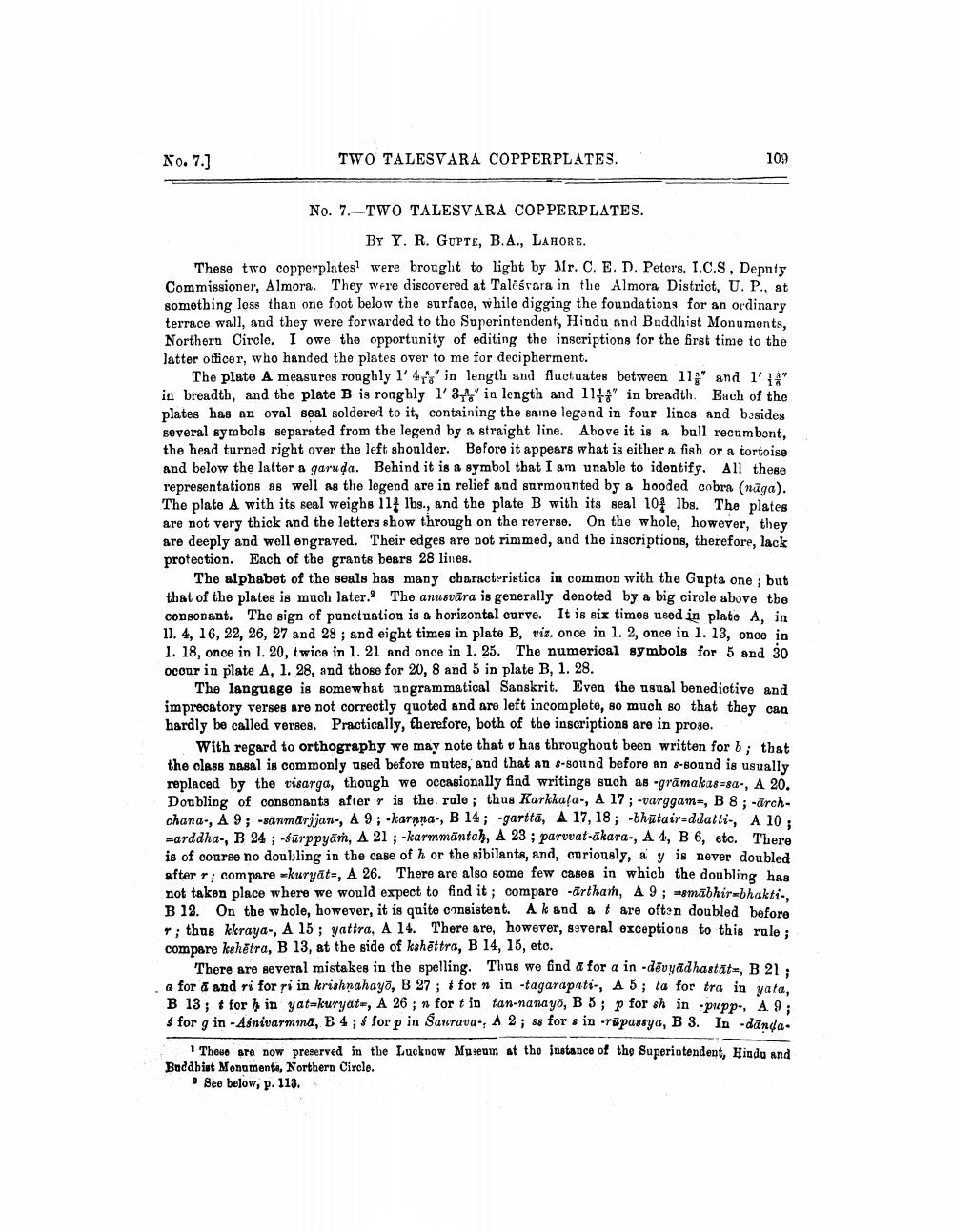________________
No.7.]
TWO TALESVARA COPPERPLATES.
109
No. 7.-TWO TALESVARA COPPERPLATES.
BY Y. R. GUPTE, B.A., LAHORE. These two copperplates were brought to light by Mr. C. E. D. Petors, I.C.S, Depnty Commissioner, Almora. They were discovered at Talēśrara in the Almora District, U. P., at something less than one foot below the surface, while digging the foundations for an ordinary terrace wall, and they were forwarded to the Superintendent, Hindu and Buddhist Monuments, Northern Circle. I owe the opportunity of editing the inscriptions for the first time to the latter officer, who handed the plates over to me for decipherment.
The plate A measures roughly 1' 47' in length and fluctuates between 114 and 1' 1" in breadth, and the plate B is ronghly 1' 31' in length and 1111' in breadth. Each of the plates has an oval seal soldered to it, containing the same legend in four lines and busides several symbols separated from the legend by a straight line. Above it is a ball recumbent, the head turned right over the left shoulder. Before it appears what is either a fish or a tortoise and below the latter a garuda. Behind it is a symbol that I am unable to identify. All these representations as well as the legend are in relief and sarmonnted by a hooded cobra (nūga). The plate A with its seal weighs 114 lbs., and the plate B with its seal 104 lbs. The plates are not very thick and the letters show through on the reverse. On the whole, however, they are deeply and well engraved. Their edges are not rimmed, and the inscriptions, therefore, lack protection. Each of the grants bears 28 lines.
The alphabet of the seals has many characteristica in common with the Gupta one ; but that of the plates is much later. The anusvāra is generally denoted by a big circle above the consonant. The sign of punctuation is a horizontal curve. It is six times used in plate A, in 11. 4, 16, 22, 26, 27 and 28 ; and eight times in plate B, viz. once in l. 2, once in l. 13, once in 1. 18, once in l. 20, twice in l. 21 and once in 1. 25. The numerical symbols for 5 and 30 ocour in plate A, 1. 28, and those for 20, 8 and 5 in plate B, 1. 28.
The language is somewhat ungrammatical Sanskrit. Even the usual benedictive and imprecatory verses are not correctly quoted and are left incomplete, so much so that they can hardly be called verses. Practically, therefore, both of the inscriptions are in proze.
With regard to orthography we may note that v has throughout been written for b; that the class nasal is commonly used before mutes, and that an 8-sound before an 8-sound is usually replaced by the visarga, though we occasionally find writings such as-grāmakas-sa-, A 20. Doubling of consonants after is the role ; thus Karkkata-, A 17; -varggams, B 8; -ārchchana., A 9; -sanmārjjan-, A 9; -karnna-, B 14 ; -gartta, A 17, 18; -bhūtair=ddatti-, A 10 =arddha, B 24 ; -fūrppyām, A 21 ; -karmmäntah, A 23 ; parvvat-Akara-, A 4, B6, etc. There is of course no doubling in the case of h or the sibilants, and, curiously, a y is never doubled after r; compare =kuryāt-, A 26. There are also some few cases in which the doubling has not taken place where we would expect to find it; compare -ārtham, A 9; =smūbhir=bhakti. B 12. On the whole, however, it is quite consistent. Al and at are often doubled before r; thug kraya-, A 15; yattra, A 14. There are, however, several exceptions to this rule : compare kshētra, B 13, at the side of kshēttra, B 14, 15, etc.
There are several mistakes in the spelling. Thus we find a for a in-dēvyadhastata, B 21 a for & and ri for ri in krishnahayo, B 27 ; # for n in -tagarapnti., A 5; ta for tra in yata. B 13 : * for h in yat-kuryat , A 26 ; n for t in tan-nanayo, B 5; p for sh in .pupp-, A 9 : $ for g in - Asnivarmmā, B 4; for p in Saurava., A 2; 88 for sin rüpassya, B 3. In -danda.
These are now preserved in the Lucknow Museum at tho instance of the Superintendent, Hindu and Buddhist Monamenta, Northern Circle.
See below, p. 113.




